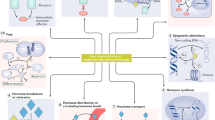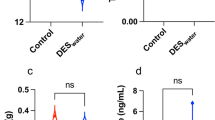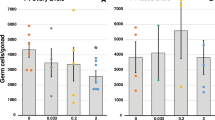Abstract
THE increase in the number of reports of abnormalities in male sex development in wildlife and humans coincided with the introduction of 'oestrogenic' chemicals such as DDT (1,1,1-trichloro-2,2-bis(p-chlorophenyl)ethane) into the environment. Although these phenotypic alterations are thought to be mediated by the oestrogen receptor, they are also consistent with inhibition of androgen receptor-mediated events. Here we report that the major and persistent DDT metabolite,P,P′-DDE (l,l-dichloro-2,2-bis(P- chlorophenyl)ethylene), has little ability to bind the oestrogen receptor, but inhibits androgen binding to the androgen receptor, androgen-induced transcriptional activity, and androgen action in developing, pubertal and adult male rats. The results suggest that abnormalities in male sex development induced by P,P′-DDE and related environmental chemicals may be mediated at the level of the androgen receptor.
This is a preview of subscription content, access via your institution
Access options
Subscribe to this journal
Receive 51 print issues and online access
$199.00 per year
only $3.90 per issue
Buy this article
- Purchase on Springer Link
- Instant access to full article PDF
Prices may be subject to local taxes which are calculated during checkout
Similar content being viewed by others
References
Sharpe, R. M. & Skakkebaek, N. E. Lancet 341, 1392–1395 (1993).
Carlson, E., Giwercman, A., Keiding, N. & Skakkebaek, N. Br. med. J. 305, 609–612 (1992).
Nelson, J. A. Biochem. Pharmacol. 23, 447–451 (1974).
Robison, A. K., Schmidt, W. A. & Stancel, G. M. J. Tox. envir. Hlth 16, 493–508 (1985).
Welch, R. M., Levin, W. & Conney, A. H. Tox. appl. Pharmac. 14, 358–367 (1969).
Gellert, R. J., Heinrichs, W. L. & Swerdloff, R. S. Endocrinology 91, 1095–1100 (1972).
Clemens, L. G., Gladue, B. A. & Coniglio, L. P. Horm. Behav. 10, 40–53 (1978).
Neumann, F. et al. Recent Prog. Horm. Res. 26, 337–410 (1970).
Wilson, E. M. & French, F. S. J. biol. Chem. 251, 5620–5629 (1976).
Kelce, W. R., Monosson, E., Gamcsik, M. P., Laws, S. C. & Gray, L. E. Tox. appl. Pharmac. 126, 276–285 (1994).
Morgan, D. P. & Roan, C. C. Archs. envir. Hlth 22, 301–308 (1971).
Dustman, E. H. & Stickel, L. F. Ann. N.Y. Acad. Sci. 160, 162–172 (1969).
Bitman, J. & Cecil, H. C. J. agric. Fd Chem. 18, 1108–1112 (1970).
Nelson, J. A. Biochem. Pharmacol. 23, 447–451 (1974).
Nelson, J. A., Struck, R. F. & James, R. J. Tox. envir. Hlth 4, 325–339 (1978).
Zhou, Z.-X., Sar, M., Simental, J. A., Lane, M. V. & Wilson, E. M. J. biol. Chem. 269, 13115–13123 (1994).
Imperato-McGinley, J., Sanchez, R. S., Spencer, J. R., Yee, B. & Vaughan, E. D. Endocrinology 131, 1149–1156 (1992).
Dürnberger, H. & Kratochwil, K. Cell 19, 465–471 (1980).
Korenbrot, C. C., Huhtaniemi, I. T. & Weiner, R. I. Biol. Reprod. 17, 298–303 (1977).
Gray, L. E., Ostby, J. M. & Kelce, W. R. Tox. appl. Pharmac. 129, 46–52 (1994).
Kupfer, D. CRC Crit. Rev. Tox. 4, 83–124 (1975).
Stone, C. R., Gray, L. E. Jr, Roberts, K. P. & Kelce, W. R. J. Androl. 16 (suppl.), 42 (1995).
Leger, J. G., Guellecand, R. L. & Tenniswood, M. P. R. The Prostate 13, 131–142 (1988).
Page, M. J. & Parker, M. G. Molec. cell. Endrocrin. 27, 343–355 (1982).
Guillette, L. J. Jr et al. Envir. Hlth Perspect. 102, 680–688 (1994).
Bouwman, H., Cooppan, R. M., Becker, P. J. & Ngxongo, S. J. Tox. Envir. Hlth 33, 141–155 (1991).
Curley, A., Copeland, M. F. & Kimbrough, R. D. Archs. envir. Hlth 19, 628–632 (1969).
Wooley, D. E. & Talens, G. M. Tox. appl. Pharmac. 18, 907–916 (1971).
Kelce, W. R. & Ganjam, V. K. Steroids 52, 217–235 (1988).
Simental, J. A., Sar, M., Lane, M. V., French, F. S. & Wilson, E. M. J. biol. Chem. 266, 510–518 (1991).
Author information
Authors and Affiliations
Rights and permissions
About this article
Cite this article
Kelce, W., Stone, C., Laws, S. et al. Persistent DDT metabolite p,p'–DDE is a potent androgen receptor antagonist. Nature 375, 581–585 (1995). https://doi.org/10.1038/375581a0
Received:
Accepted:
Issue Date:
DOI: https://doi.org/10.1038/375581a0
This article is cited by
-
Exposure to environmental chemicals and cancer risk: epidemiological evidence from Japanese studies
Genes and Environment (2023)
-
Emerging evidence that the mammalian sperm epigenome serves as a template for embryo development
Nature Communications (2023)
-
Towards Complete Kinetic and Thermodynamic Description of the Degradation of Persistent Organic Pollutants in Soil Ecosystems on the Basis of the Multi-phase Pseudo-zero Order Rate Law: A case Study of DDE in Philippine Soil
Chemistry Africa (2023)
-
Temporal decline of sperm concentration: role of endocrine disruptors
Endocrine (2022)
-
Environmental disruptors and testicular cancer
Endocrine (2022)
Comments
By submitting a comment you agree to abide by our Terms and Community Guidelines. If you find something abusive or that does not comply with our terms or guidelines please flag it as inappropriate.



